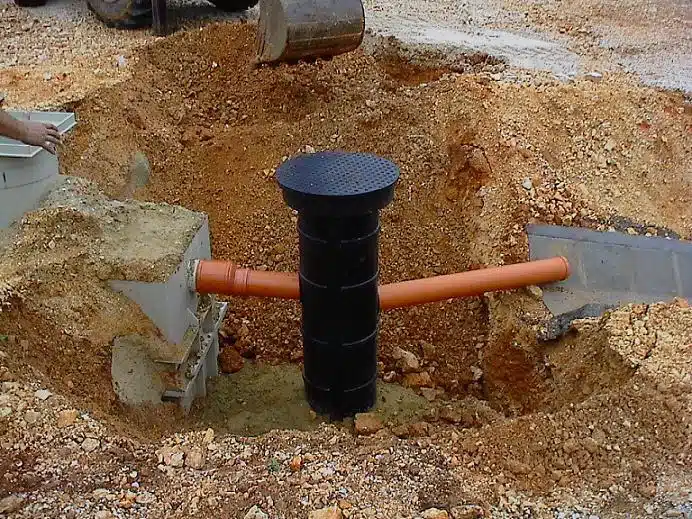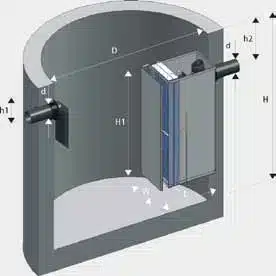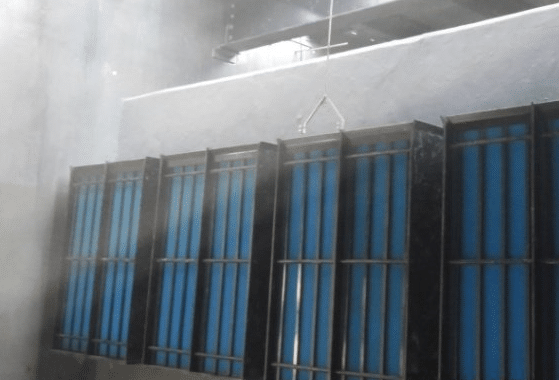Utah’s beautiful landscapes hide a valuable resource under the ground – our groundwater. As cities grow and industries expand, we need effective Utah Below Ground OWS (OWS) more than ever. These systems are key to keeping our aquifers clean, but are we using them well?
The Utah Department of Environmental Quality knows how important it is to protect our drinking water. They set strict rules for onsite wastewater systems. By focusing on storing water underground and recharging aquifers, we can keep our groundwater safe for the future. But with more environmental issues, we must wonder: Are we doing enough?
Key Takeaways:
- Utah Below Ground OWS are essential for protecting groundwater quality
- The Utah DEQ provides guidance on using alternative OWS in sensitive areas
- Prohibiting conventional OWS in certain zones helps safeguard drinking water sources
- Alternative OWS must meet strict nitrogen reduction standards
- Effective groundwater conservation relies on proper OWS implementation and maintenance
Understanding Below Ground Oil Water Separators (OWS) in Utah
Below Ground Oil Water Separators are key in Utah for protecting the environment. They help keep water clean and protect natural resources across the state.
Definition and Purpose
These systems are made to separate oil and other hydrocarbons from water. They let oil float to the top while water goes down. This way, they remove contaminants before water goes back into the environment.
Environmental Protection
In Utah, Below Ground Oil Water Separators are vital for protecting groundwater. They stop harmful substances from getting into aquifers and water systems. This keeps Utah’s valuable water safe for future generations.
Regulatory Framework
Utah has strict rules for Below Ground OWS. The state’s Department of Environmental Quality makes sure of this. They have rules like the Ground Water Quality Protection Rule and Onsite Wastewater Systems Rule.
These rules cover how to install, run, and maintain OWS systems. They make sure these systems work well to protect Utah’s water resources.
Utah’s Groundwater Resources and the Role of OWS
Utah’s groundwater is key to the state’s water needs. These underground reservoirs hold a lot of water, helping communities and nature. The Navajo and Lambs Point aquifers in the Kanab Creek Watershed show how pure Utah’s groundwater is.
Overview of Utah’s Aquifers
Utah’s aquifers are top-notch, rated as Class 1A Pristine Ground Water. They are essential for storing water underground. This helps keep the water supply steady when it’s dry. Efforts to recharge these aquifers are crucial.
Threats to Groundwater Quality
Even though Utah’s aquifers are clean, they could get contaminated. Septic tanks are a big worry, especially with nitrate, which moves easily in soil and can be harmful to health. Pollutants from industries and farms can also get into these underground water sources, risking their quality.
OWS Contribution to Aquifer Protection
Below Ground Oil Water Separators (OWS) are vital for protecting Utah’s groundwater. They clean wastewater, stopping pollutants from getting into aquifers. By taking out oil and pollutants, OWS help with recharging the aquifers and keep drinking water safe. Utah has set up special areas around wells and springs to make OWS even more effective in keeping groundwater clean.
Utah Below Ground OWS: Design and Installation Standards
Utah is serious about protecting its underground water and replenishing aquifers. It has strict rules for Below Ground Oil Water Separators (OWS). These rules help keep groundwater safe and support good water use.
Technical Specifications
OWS in Utah have to meet certain standards. They must have a minimum capacity of 1,500 gallons. The tanks are checked for leaks and have specific cover depths.
Every septic tank outlet needs an effluent filter. This filter helps catch more contaminants, making the system work better.
Site Assessment Criteria
Choosing the right spot for OWS is key. Experts look at soil type, water table levels, and how far it is from water sources and property lines. This careful planning helps place OWS in the best spots for storing and replenishing underground water.
Installation Best Practices
Installing OWS follows strict rules to ensure they work well. Absorption systems have to be set up just right, with the right trench spacing and digging methods. Observation ports are added to check on the system and help with upkeep.
These steps help protect groundwater and support sustainable water use in Utah.
Maintenance and Operation of Below Ground OWS in Utah
Keeping below ground oil water separators (OWS) in good shape is key for protecting Utah’s groundwater. Regular checks make sure these systems work right, keeping aquifers clean. Utah says certified pros must check them often to keep the water safe.
Utah’s rules call for wells and springs near OWS to be checked every six months. This helps spot any issues that could harm the groundwater. Also, making sure septage and sludge are disposed of correctly is important. This stops bad stuff from getting into our water.
Places like Best Friends Animal Society in Kane County stick to strict OWS rules. They hire State of Utah Certified Onsite Professionals for regular checks. This helps with efforts to protect Utah’s water for the long term.
By following these maintenance steps, Utah’s below ground OWS systems help keep our groundwater safe. Regular care meets regulations and helps manage water wisely for the future.
Environmental Benefits of Implementing Below Ground OWS
Below ground oil water separators (OWS) are key in protecting Utah’s environment. They help keep groundwater safe and support sustainable water use.
Reducing Hydrocarbon Contamination
OWS systems separate oil from water before it’s released. This cuts down on hydrocarbon pollution in groundwater. It helps keep Utah’s aquifers safe.
By treating wastewater on-site, these systems ease the load on big treatment plants. This supports better water management.
Supporting Sustainable Practices
Using below ground OWS promotes sustainable water use in Utah. These systems keep aquifers and aquatic ecosystems safe. They treat water right where it’s needed, saving energy and resources.
Long-term Ecological Advantages
Utah’s ecosystems gain a lot from below ground OWS. These systems stop pollutants from getting into waterways. Modern OWS technology can remove up to 5 PPM of pollutants, meeting strict discharge limits.
This ensures long-term protection of groundwater.
Case Studies: Successful Implementation of Below Ground OWS in Utah
Utah Below Ground OWS systems have shown they can protect our vital aquifers. Let’s look at a success story that shows how these systems work well in real life.
The Best Friends Animal Society in Kane County is a great example of how OWS works well. This huge 5,800-acre place shows how to manage wastewater in a sensitive area. It uses 65 systems to handle 39,030 gallons of wastewater every day.
For handling strong wastewater, the place has four special tanks. This setup makes sure wastewater is treated right and keeps nearby water safe. They check and follow rules closely to keep the aquifer safe.
This story of the Best Friends Animal Society shows how Utah Below Ground OWS protects our water. By managing a lot of wastewater, these systems help keep Utah’s groundwater clean. This success story is a guide for others wanting to improve their environmental care with better wastewater treatment.
Freytech Inc.‘s Contribution to Utah’s Below Ground OWS Solutions
Freytech Inc. is key to protecting Utah’s environment. They offer top-notch below ground oil water separator (OWS) solutions. These are made for Utah’s specific needs.
Enhanced Coalescing Technology
Freytech Inc. uses advanced coalescing technology in their OWS systems. This tech greatly improves separating oil from water. It helps keep Utah’s groundwater safe.
Impressive Separation Efficiency
The OWS solutions from Freytech Inc. have a 5 PPM separation efficiency. This is way better than the North American standard of 10 PPM. It shows the company’s dedication to protecting the environment.
Customized Solutions for Utah
Freytech Inc. knows Utah has unique environmental issues. They create OWS solutions that meet these needs. These systems can separate different hydrocarbons like motor oil, diesel, gasoline, and jet fuel.
For tougher cases, Freytech’s separators can get down to 0.1 PPM for trace amounts of emulsified oil. Freytech Inc. plays a big role in keeping Utah’s groundwater clean. Their focus on innovation and caring for the environment makes them a key partner in protecting Utah’s water.
Conclusion
Utah Below Ground OWS systems are crucial for protecting the state’s groundwater. They work hard to keep Utah’s aquifers clean and safe. With strict rules and advanced technology like Freytech’s coalescing systems, Utah leads in groundwater protection.
These systems do more than just meet standards. They help Utah manage water sustainably for the future. They cut down on hydrocarbon pollution and support diverse ecosystems, keeping Utah beautiful.
Looking ahead, the role of Utah Below Ground OWS in protecting groundwater is vital. These systems are a smart choice for Utah’s environment and water safety. By improving this technology, Utah will have a cleaner, safer water supply for future generations.
These separators are crucial in storm water systems. They process runoff to meet the US EPA’s Clean Water Act standards. With effective oily water treatment, facilities protect the environment and dodge big fines.










